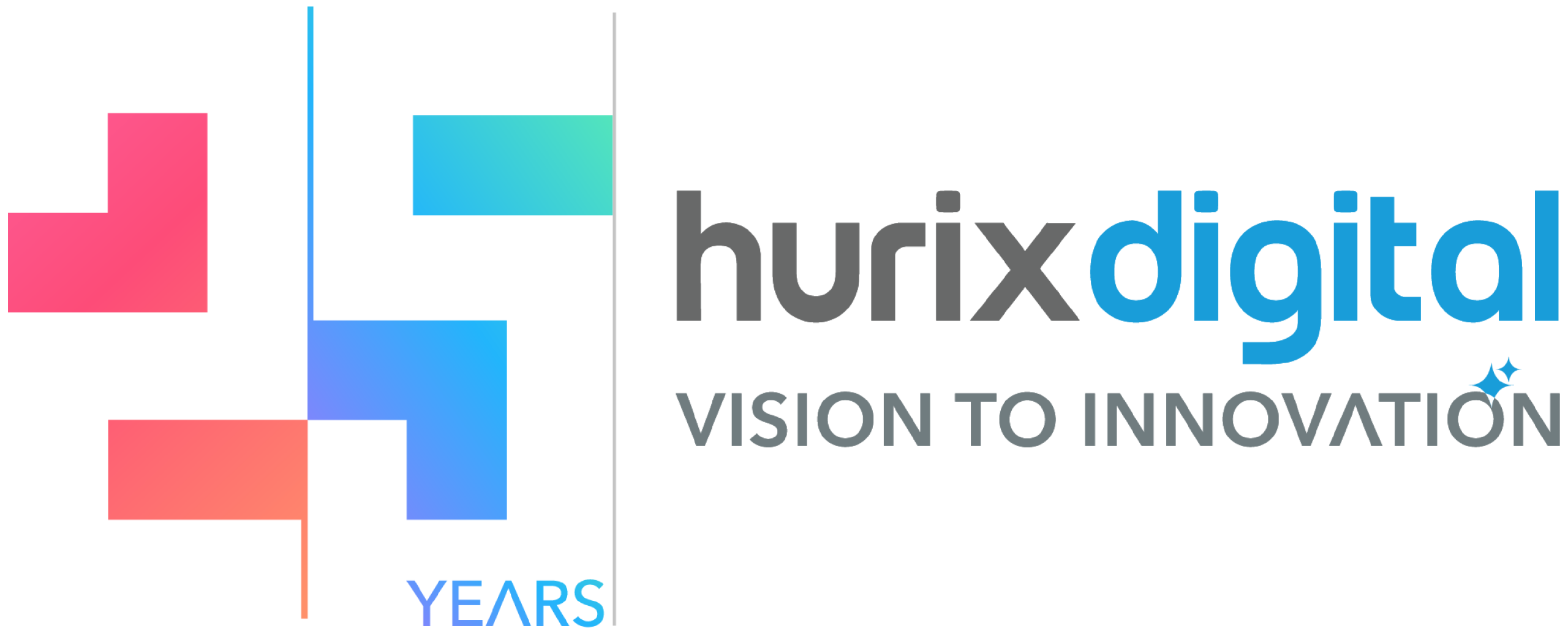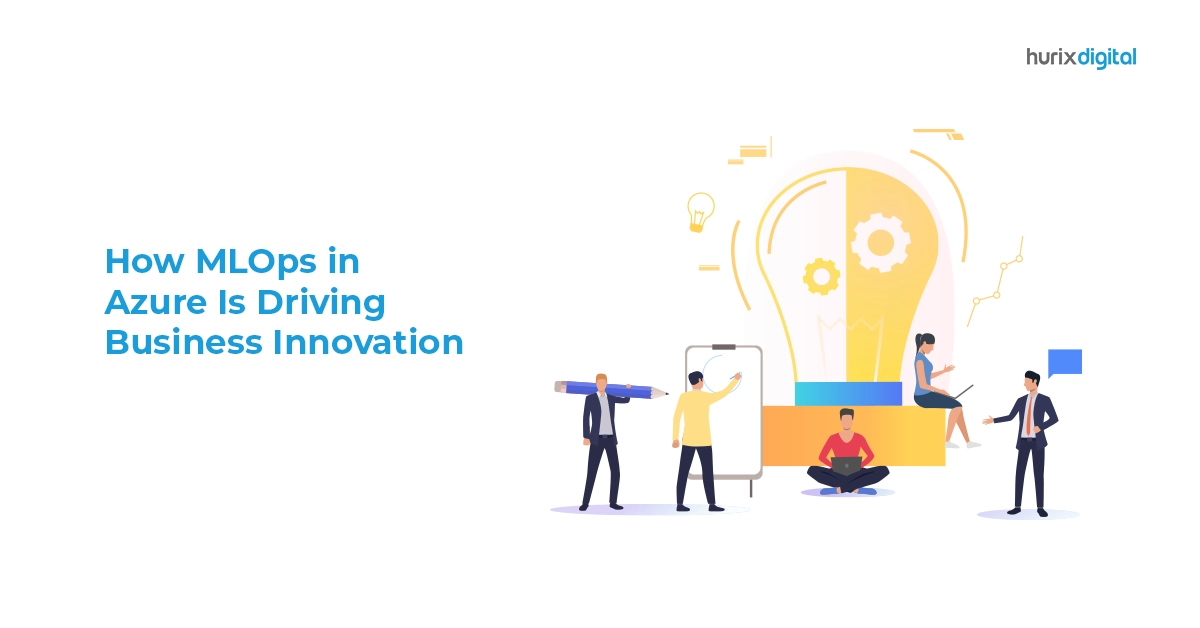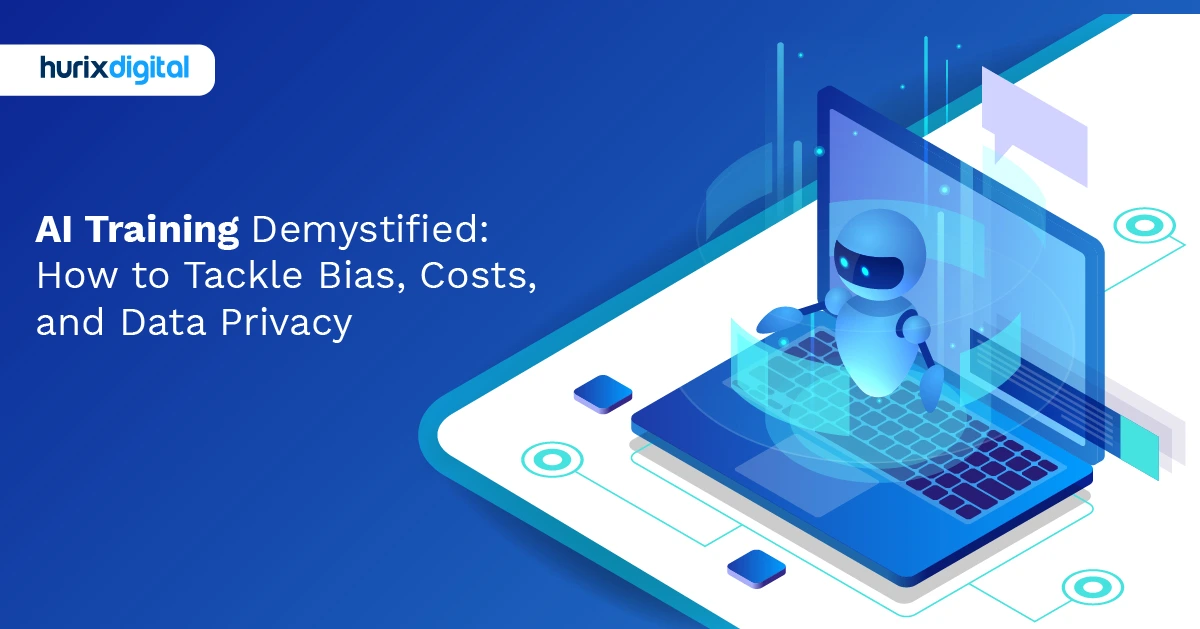
Gokulnath B
August 25, 2025
Top AI Model Training Challenges Every Organization Must Overcome
The prospect of AI seems within reach for many organizations, with its strength widely promoted. However, achieving AI efficacy is more complex than it appears. Model training involves intricate issues where poor data quality can cause major problems, and minor calculations may lead to significant infrastructural work. Turning an AI model into reality is not just technical; it also involves data integrity, resource allocation, fairness, and trust.
Understanding this capability is key. It’s one thing to discuss future possibilities; it’s another to turn those into tangible actions. Building the foundation behind ‘what-if’ ideas involves challenges, especially when justifying investment to executives. Successful AI implementation demands foresight, problem-solving across technical, ethical, and organizational domains, and an integrative approach.
Let’s understand all about AI model training, you as an organization, would like to know more about!
Table of Contents:
- How Important is Data Quality for Effective AI Model Training?
- What are the Significant Computational Resource Demands for AI?
- How to Mitigate Bias for Fair AI Model Training?
- Why is AI Model Explainability Important for Leadership Trust?
- What are the Unforeseen Costs of Scaling AI Model Training?
- How to Ensure Scalable and Future-Proof AI Model Training?
- Measuring ROI and Justifying AI Training Investments to Stakeholders
- Addressing the Skill Gap for Advanced AI Model Development
- Establishing Ethical AI Governance Guidelines for Training Processes
- Optimizing MLOps for Efficient AI Model Deployment and Lifecycle
- Conclusion
How Important is Data Quality for Effective AI Model Training?
We often hear “data is the new oil.” It’s a catchy slogan, no doubt, but perhaps a little misleading. Oil, even in its crudest form, still holds inherent energy. Data for AI, however, operates quite differently. It’s less about sheer volume and everything about its quality. Think of it not as fuel, but as the intricate blueprints for a complex building. If those blueprints are smudged, incomplete, or fundamentally wrong, then the structure, no matter how brilliant the architects or skilled the engineers, is going to be fundamentally flawed from day one. For an AI model, training data isn’t just input. It is the world that it learns to understand. Poorly represented worlds full of missing info, contradictions, or errors cause the model not only to learn these flaws but often worsen them. For instance, a diagnostic AI trained on scans from a specific demographic or with mislabeled subtle anomalies develops blind spots. It excels with familiar cases but struggles or errs outside its biased experience. The way poor data quality is insidious is through how frequently it is opaque to the practitioner. You can spend hours honing algorithms, tuning hyperparameters, and preparing beautiful architectures, and in the end, you will find that you cannot have your model remember anything from the training period. We have all encountered that moment of despair, the moment of understanding that the problem was not with the modeling and the advanced code, but only an unnoticed data entry error weeks or months back that somehow was ensconced across the whole training set. That’s like developing a high-performance engine, only to have fuel lines blocked at the beginning. Any data practitioner can tell you perfection is an unrealistic goal. No dataset is pristine. The ability is not in seeking a perfect dataset, but in understanding datasets and their imperfections, biases, and gaps. It is getting to know your raw material, knowing well where the strengths of the material are and where the weaknesses of it are. Without this knowledge, the newest AI frameworks are just highly efficient models of misunderstanding.What are the Significant Computational Resource Demands for AI?
The computational demands of artificial intelligence are truly astounding. It requires not just an upgraded laptop but a massive data center. Think of it less as using a basic calculator and more like building an incredibly large and complex cathedral brick by brick, and then needing to be able to power it 24/7. When a large AI model goes through its training, it absorbs petabytes of data. For this purpose, graphical processing units tend to do the heavy lifting here. GPUs are exceptional for parallel processing, meaning they can process millions of calculations at the same time. A single, powerful GPU can run several thousand, and yet you are not using a single GPU. You are using hundreds, often thousands, of GPUs, networked together in large clusters. The energy footprint is huge. Training a foundational model can use as much power as a small town for weeks, sometimes months. This is not a hypothetical scenario; it reflects a real and pressing demand. The heat produced is another quiet but crucial challenge. Controlling temperature in these server farms requires large cooling systems, which adds to the energy bill. It’s a difficult loop: more power for computation leads to more power for cooling that computation. And it’s not just during training. Inference, which is using a trained model to make predictions or create content, is less demanding but still takes significant resources, especially for real-time applications like self-driving cars or advanced virtual assistants. You need a well-tuned machine ready to react immediately. The sheer scale of these operations inspires both awe and concern. Can we keep up this pace of exponential growth forever? What will happen when we reach the limits of semiconductor physics? This question weighs on many in the field.How to Mitigate Bias for Fair AI Model Training?
Bias in AI is not some abstract, mathematical issue. The world is, in part, a reflection of human society itself, often to ugly effect. Consider: our models are trained on data that is full of human decision-making, which is tens or hundreds of years old. Should such judgments be skewed, consciously or not, then that is what the data reflect. And the model will obediently learn that and exercise it. Fair training of AI models must begin way back before a single line of code is written. It starts at the data, which is where most battles are won or lost. The general attitude is that more information is preferable. This is not the case. More representative data is superior. It is not all about making a demographic balance, such as having sufficient representations of all skin tones in a facial recognition data set. It has to do with context, about historical trends. The lending business is a good example. When loan growth history favors one group over another, due to ingrained biases in the system’s unseen economic logic, then a model trained on that history will adopt the same preferences. To address this, we must actively remove that historical bias by sometimes excluding features that, although seemingly neutral, actually stand in for those biases. Or even more controversially, by deliberately oversampling underrepresented groups or by weighting different outcomes more or less heavily.Why is AI Model Explainability Important for Leadership Trust?
It is rare for a leader to be presented with a major decision and have his or her immediate reaction be to say, “Just tell me what the computer says.” It is “Tell me why.” They should get the logic, the rationale. It is the basic human desire, is it not? All of us have to figure out how and why we must make a certain choice. This is not a lure in the case of AI models but the foundation of trust. Consider projecting a significant change in investment on the basis of nothing except the advice of an AI: In short, the algorithm ran the numbers.” The room is losing confidence. It is not the question of the power of AI but the power of a human to explain and possess the decision. AI is an ingenious silent oracle without explainability. How do you address or locate risks when you have opaque reasoning? A market shift or a change in regulation may result in what was supposed to be a genius prediction, and nothing can be explained as to why it did so, and how the prediction can be salvaged. This is not only comfort but accountability. Systems such as AI will inevitably fail, and leaders will be required to take responsibility to shareholders, employees, and the general population. It is not sufficient to blame an unexplainable model. Explanations will allow auditing, debugging, and drilling down on biases that can lead to damage. They are converting obscure hints to practical counterpoints. When executives are knowledgeable, they will know how to seamlessly incorporate these tools into everyday practice and eventually make AI no longer an ominous dark box but a trusted partner. This is necessary in attaining leader trust and organizational backing.What are the Unforeseen Costs of Scaling AI Model Training?
Most people, when talking about scaling AI, focus on the hardware. The GPU bill. The electricity meter running awry. These numbers are big, sure. But let’s talk about the costs that sneak up on you, the ones that don’t fit neatly on an invoice. Start with data. Gathering more is one thing, but wrangling it is where the real headache sets in. Small models? They let some dust slide under the rug. Big models? Every speck turns into a mountain. Suddenly, you need armies of people: skilled annotators to painstakingly label samples, domain experts arguing over tricky cases, and robust rules to keep bias at bay. Don’t think the computer does it all. This is manual, high-skilled labor. Entire teams work full-time just to keep things tidy. It’s the secret tax of progress. Then there’s brainpower. Little models still make sense; you can open them up and see what’s ticking. Scale up, and they turn into black boxes. Why did it spit out that bizarre prediction? Is it a rogue bit of data, a bug in the architecture, or just statistical weirdness? You’ll spend weeks, sometimes months, wading through logs, chasing obscure clues. The financial cost is steep, but the real pain is in lost momentum and grumpy engineers burning out. Finally, beware of technical debt. What felt like a handy shortcut in a small project becomes a sprawling mess no one wants to touch. Scripts glued together, barely explained. The bigger the project gets, the uglier this becomes. Fixing it slows everything down, drains budgets, and chips away at your team’s patience.How to Ensure Scalable and Future-Proof AI Model Training?
Making AI model training scalable and truly ready for the future calls for a blend of craft and common sense, not just a mindless upgrade of processing power. You don’t fix a leaky roof by adding more floors to the building. The wise move is to start with a solid plan before the first data arrives, before the first sketch of a neural network sees the light of day. Take the data pipeline. Many projects stumble when they realize the pipeline was perfect for last year, but now a new sensor appears, and nothing fits. That’s like building a shiny car and forgetting the gas cap. Keeping data organized with version numbers, mapping exactly where it comes from, and designing flexible data structures can save you heaps of trouble. You may think every possible data source is covered, but customers and markets have a funny way of surprising you. An adaptable data ingestion process is like packing for all seasons, so you aren’t caught shivering on a summer afternoon. Now, picture the computing side. Throwing everything onto the cloud sounds simple until budget and privacy wake you in the middle of the night. The smart approach is deciding when to send heavy jobs to the cloud, when to keep tasks local, and how to stretch resources without them snapping. Training loops need to run across many machines at once, without having idle servers sipping coffee in the background. Focus on scaling up for today, but always leave room for tomorrow’s ambitions. If you set everything in stone for a small model, don’t be shocked when bigger ideas outgrow it. Building with distributed frameworks from the start keeps things flexible. Don’t forget the backbone, the MLOps discipline, the keeper of order in a world of change. The goal isn’t to make something shiny that breaks when you touch it. It’s to have a system where a swap of an algorithm or a tweak in feature engineering feels more like a friendly handshake than an arm-wrestling contest. When the model needs retraining, say, because customer tastes shifted overnight, your workflow should notice, take action, and update everything on its own. Track experiments, version every piece, pay attention to data drift, and automate every dull task you possibly can. It’s the quiet, steady routines that let your AI system do somersaults when the market throws a curveball. That’s the difference between a system that survives change and one that falls flat.Measuring ROI and Justifying AI Training Investments to Stakeholders
Convincing stakeholders to open their wallets for AI training? Yeah, it’s rarely a walk in the park. You’ll see some reach for their calculators, eyes aglow, hoping for a swift “X percent ROI” answer. And sure, sometimes that calculation pops right out. Teach a bot to spot manufacturing defects and you’ll watch waste and rework shrink. The finance team high-fives, and everyone feels clever. But here’s where things get spicy: what about those sneaky, slow-burning benefits? The kind that no spreadsheet seems to capture. Picture a bank deploying AI to sniff out weird market patterns. Maybe it won’t set off fireworks in the quarterly earnings call, but what if it quietly dodges catastrophic losses, or just starts nudging trades in the right direction? Who gets credit for steering the ship clear of an iceberg nobody saw? And how do you translate “a thousand slightly smarter moves” into a glossy PowerPoint graph? Spoiler: you can’t, at least not perfectly. Sometimes, it’s less about counting every dollar and more about tracking “analyst hours saved” and running with an educated guess. Not rock-solid, but it gets you started. Let’s talk about ROI beyond the black-and-white ledger. Imagine an AI system that makes customers feel like VIPs with smart recommendations, “How did they know I needed this?” moments, that kind of magic. Does it boost loyalty? Almost certainly. Can you bottle up brand love and slap a price tag on it? Good luck! The truth is, those fuzzy, feel-good gains often outlast and outshine a quick financial uptick. Here’s another twist: sometimes the real cost is doing nothing. If your rivals are racing ahead, using AI to fine-tune their supply chains or second-guess the market, you risk growing cobwebs while they’re out winning trophies. There’s no line for “being left behind” in your accounts, but you’ll feel it when market share quietly slips away. So, when the debate heats up, it’s time to get bold: call these investments “foundational.” You’re shaping how your whole team thinks and reacts, making every future decision a little sharper. It’s future-proofing. You might not always get to ring the bell for money earned, but avoiding what you could’ve lost? That’s a win in any book.Addressing the Skill Gap for Advanced AI Model Development
Closing the skill gap for advanced AI model development is about a deep understanding of the underlying mathematics, statistics, and human biases that go into producing outputs. Many individuals who are proficient with frameworks are at a loss when it comes to diagnosing which part of a complex model has failed. They lack the architectural and ethical understanding to advance the field. Building advanced AI isn’t simply following the recipe for a dish, like using the sample code from a framework, but rather, it is inventing a dish, knowing the chemistry of its ingredients, and knowing when to toss out an ingredient that is harmful. It entails a mindset that is comfortable with ambiguity, curiosity, and thousands of hours working through complex concepts. Even the most seasoned experts often struggle to comprehend the latest research. Therefore, the world of artificial intelligence requires networked and continued learning, and having what we call a beginner’s mindset. So, how do we close the gap? It isn’t about creating a factory of AI engineers; it is about building spaces for understanding and conceptualizing a model. We need to think about education pathways and how we can promote interdisciplinary studies between aspects of computer science, cognitive psychology, ethics, and philosophy. Besides formal education, some of the best ideas come from establishing internal incubators that pair more senior researchers mentoring smaller teams to engage in complex problem-solving for real-world problems. We are not just developing technicians, but thinkers; it is a long game that privileges understanding over speed and time-intensive robust development over fast-tracking deployment. Fundamentally, it is more about a cultural shift than a training program.Establishing Ethical AI Governance Guidelines for Training Processes
Establishing strong ethical AI governance for training processes is not a simple task to complete. It is a continuous commitment that is woven into daily work. Consider the foundation: the data. It’s easy to say to ensure data quality, but the real challenge is understanding how representative it is. An AI model trained on past data, for example, to predict loan defaults, will inevitably inherit the biases found in earlier lending decisions. If certain demographic groups were historically redlined or offered worse terms, the model will learn to repeat those patterns without any intention to do so. It’s not the algorithm’s fault; it simply reflects our shared history, now digitized. Next is the training phase, where people often imagine a fully automated, perfect process. Yet human involvement is as important as choosing models, setting parameters, and defining success metrics. If an engineer prioritizes accuracy over fairness for different groups, they may unintentionally create a system that performs well overall but fails for a specific, underrepresented group. It’s like a doctor focusing on average health while ignoring a small group’s serious illness. These oversights aren’t out of malice but reflect governance failures. Effective governance requires constant attention, prompting teams to ask tough questions: Is this outcome fair? Are unexpected behaviors emerging? It involves checking the process and results, keeping records of data sources, explaining model choices, and noting performance across groups. Perfection is unattainable, with trade-offs and conflicting ethical priorities. The aim isn’t perfect AI but AI with human care and awareness of impacts. It’s complex, ongoing work requiring humility and adjustments.Optimizing MLOps for Efficient AI Model Deployment and Lifecycle
Optimizing MLOps for efficient AI model deployment and its lifecycle shows that it’s less about a single, large system and more about a series of careful, interconnected small improvements. It resembles tuning a classic car. You can’t simply add a turbo and expect everything to work. Every part needs attention and must work together. The biggest trap is focusing only on the model itself. A model is just a complex set of numbers if the data feeding it isn’t reliable, if the features aren’t consistent, or if the environment it runs in is unclear. True optimization happens when the entire pipeline, from data ingestion to feature engineering, model training, validation, deployment, and crucial monitoring, flows smoothly. Think about automation. It’s not just about creating a CI/CD pipeline for code. It also includes automated data validation checks before training starts. Consider the silent failures that occur when a schema changes upstream, and your model trains on faulty data. That’s a real headache. An efficient MLOps setup automatically flags these issues, preventing a costly model redeployment later. It’s about adding safety measures throughout the process, not just at the end. Then there’s model monitoring. It goes beyond just tracking prediction accuracy; that approach is often too late. The real value lies in detecting data drift and concept drift early. Is the input data changing in ways the model hasn’t encountered during training? Is the relationship between features and targets shifting in reality? Someone should notice these changes before they affect the business. Setting up alerts for statistical shifts in feature distributions, not just model performance, is essential for efficient operations. It’s about being proactive and catching subtle signals before they develop into significant problems. Sometimes, human judgment is necessary to interpret those signals. No system is perfect, after all.Conclusion
AI’s potential is vast, but realizing its value is complex. In addition to ensuring quality data and ethical practices, managing resources and ROI, taking a holistic approach is essential. If we proactively address these challenges, we will be able to establish truly valuable and trustworthy AI. Organizations with a responsible and effective AI strategy are the future. By consistently addressing issues like data quality, scalability, bias and fairness, explainability, and ROI measurement, you can transform AI from just an aspirational idea into a real business asset that drives measurable growth and innovation. Get started with Hurix Digital today and move your AI vision forward. Contact us to learn more about how we can help you address your training challenges with our proven AI development solutions to accelerate sustainable success with AI.
Vice President – Content Transformation at HurixDigital, based in Chennai. With nearly 20 years in digital content, he leads large-scale transformation and accessibility initiatives. A frequent presenter (e.g., London Book Fair 2025), Gokulnath drives AI-powered publishing solutions and inclusive content strategies for global clients
 A Space for Thoughtful
A Space for Thoughtful 



